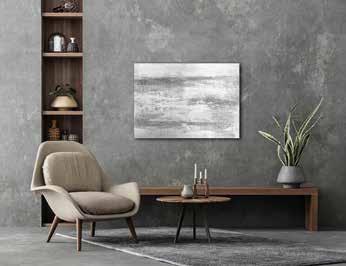
3 minute read
Paintings with Purpose
Artist, writer, and spiritual junkie Kerry Hussain has some strong opinions about how art can affect our wellbeing. In this eloquent article, written especially for Swealthy, she tells us exactly why she thinks everyone needs art in their life.
also help our minds to relax but making time for stillness every day is the best way to bring our bodies into homeostasis, the internal balance that we need to survive. Meditation is a growing trend – recent advances in neuroscience have proven its positive effect on our brain, lifting it out of the realm of spirituality and dropping it into the mainstream. If you want to experience its benefits for yourself but aren’t sure where to start, the good news is that you don’t have to go all ‘Eat, Pray, Love’ and hot-foot it to an ashram in India for six months. You don’t have to get up at 4am and devote your morning hours to sitting in silence in the lotus position. In fact, you don’t even have to close your eyes. Introducing a few consciously considered and strategically placed pieces of art to your home can be an easy and effective way to encourage moments of mindful contemplation.
Advertisement
Seeing with your heart
Slow looking, or visual meditation as I call it, is a directed mindfulness practice that uses art to take us off auto-pilot and bring our awareness into the present moment. All art provokes an emotional reaction, and by purposely engaging with it, it acts as a mirror, reflecting your true feelings back at you. Understanding the artwork itself is not important, it’s simply a tool you can use to understand yourself. The late Buddhist monk and Zen Master, Thich Nhat Hanh, said, “To see deeply, we have to first learn the art of stopping.” Looking at art forces you to stop, and taking the time to study a piece with deliberate intention (I recommend a minimum of ten minutes) helps you to connect with your inner self. It then coaxes you to go deeper, to explore the emotions that arise and to become aware of the sensations inside your body while doing so. Studies have shown that viewing art can reverse the effects of stress, lowering heart rate and blood pressure.
Choosing art that will elicit this reaction is instinctive. Quite often, it is difficult to explain why you like a specific piece in the same way that you are unable to define exactly why you find certain individuals more romantically attractive than others. Indeed, aesthetically pleasing art triggers the same physiological response as falling in love: blood flow to the brain increases by as much as ten percent and when the pleasure zones are activated, serotonin and dopamine (aka ‘the bliss chemicals’) are released.
Landscapes and scenes of nature are widely regarded as the best at invoking inner tranquility, with works by French Impressionist painter Claude Monet cited as among the most relaxing. A well-balanced composition is essential. Avoid anything that is too busy or graphic, or text-based pieces with heavy, angular lines, as these can actually increase anxiety and tension – a definite no-no for bedrooms! A Harland Miller piece might look cool but it isn’t exactly conducive for a relaxing night’s slumber.
Colour me happy
Regardless of the subject matter, colour can play a huge role here. It stands to reason that soft, muted colours will have a more calming effect than bright, vibrant ones. Pale pink is the colour of love and compassion and has been scientifically proven to reduce anger. After a stressful day, walking into a hallway and seeing a painting with subtle rose tones can instantly dissipate any commuter rage and ensure you leave work at the door. For obvious reasons, art with elements of pink also makes a great choice for bedrooms, but if that feels too feminine, try something with natural, earthy tones to help you get grounded and increase your sense of safety and security.


The bathroom is often the place to which we retreat when in need of some peace and solitude. Hanging art in here can invite you to linger for longer and fully unwind. Green is a very restful colour, particularly shades of sage or jade, so gaze at pieces that use these while you soak in the bath.
Colour can arouse different emotions depending on the individual, so it is important to become aware of how they make you feel on a personal level, despite what definitions may be accepted across the board. For example, blue is regarded as a deeply restful and calming colour, but for me, growing up on a small island surrounded by the sea with a lot of unhappy memories, it triggers feelings of anxiety and claustrophobia. I feel much more centered when I’m surrounded by the colours of the forest, as this is my happy place. Recognising your ‘safe’ colours is critical to finding art that will cultivate inner peace.
This holistic approach to viewing art – seeing with your heart, not just your eyes – strengthens the mind/body connection, which can enhance the meditative experience. While it may not replace medication for more serious conditions, it can certainly be used to combat everyday stress and mood-based challenges. By using art to create a peaceful environment and learning to unlock its healing power, you are not only enhancing your home but also adding a valuable asset to your self-care toolkit.
For more from Kerry, visit: www.kerryhussain.com or check out her instagram @artforthesoul_11







